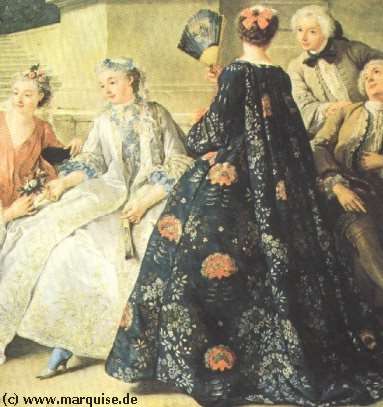| INDEX | 1300-1599 | 1600s | 1700s | 1800s | 1900s | CROSS-ERA | ETHNO | |
| MISCELLANY | CONTACT | SEARCH | |
|
|


Declaration of Love by François de Troy, 1731
During the 1720s and 30s, the hoop skirt spread like fire - in both senses of the word. It developed from cone to dome shape , then gradually flattened in front and back. The horizontal decoration made way for plain fabrics and large floral designs.
Typical colours are pale and greyish and variations of red from pale pink to brilliant red, or of blue from blueish silver to dark blue. In general, pastel colours were the most popular. With indigo coming in from India, dark blue was very popular for a while.
The most important feature of this era is the advent of the contouche or sack dress. Like the manteau, it had developed out of deshabillé and was, around 1717, discounted as sloppy and too intimate by Elisabeth Charlotte d'Orleans. But since the death of Louis XIV in 1715, there was no court anymore, hence no call for the formal, stiff and uncomfortable grand habit, so ladies got used to this "sloppiness".
Unlike the manteau, the contouche was not pleated to shape with the bck pleats stitched down, but left hanging loose. A mass of fabric flowed down from a cluster of large box pleats on either side of the centre back. The painter Antoine Watteau was so fascinated by the elegance of this dress that he painted it over and over again, which is why the pleats are known as Watteau pleats. In these early years, the contouche still very much resembled a wrapping gown and was either closed down the front from the waist down, or open but ample enough to slightly wrap the fronts over each other.
In this picture, the lady to the right shows us the Watteau pleats and sleeve cuffs and a bit of her fan which seems to have a landscape painted on it. She appears to wear an oval hoop skirt that reaches just below knee level. The left lady is untypically high-necked. We see powdered hair with a small bonnet, its ribbons hanging over the shoulders. The front of her contouche is almost closed, and we can almost imagine her wrapping the right side over the left. It is also interesting to note that stockings were not necessarily white, shoes impossibly small, and the front of the skirt considerably shorter than the back.
At court (after the inthronisation of Louis XV and outside France) and for similarly formal occasions, the style seen on the previous page (i.e. boned bodice and separate skirt) was still worn but had undergone slight change. The train had developed a life of its own: It wasn't merely there because the overskirt was so long, but was deliberately cut as an appendix attached to the waist which was folded up over the wide panier and to the back. England had developed something similar out of the old mantua, now forgotten on the Continent: the front edges of the manteau skirt were gathered up and back and made almost to meet in back, in the vicinity of the edge of the folded-up train.
Hairdos returned to the vicinity of the skull and were rather
simple. The hair was arranged in buns or little locks, decorated
with ribbons, feathers, jewels etc and powdered grey or white.
Sleeves were about elbow-length with "winged" cuffs
from which the lace frills of the chemise flowed.
| <<<PREVIOUS | NEXT >>> |
The music is A Serpina, penserete from the intermezzo La serva padrona (1733) by Giovanni Battista Pergolesi. Sequenced by yours truly.
Content, layout and images of this page
and any sub-page of the domains marquise.de, contouche.de, lumieres.de, manteau.de and costumebase.org are copyright (c) 1997-2022 by Alexa Bender. All rights reserved. See Copyright Page. GDPO
This work is licensed under a Creative Commons License.